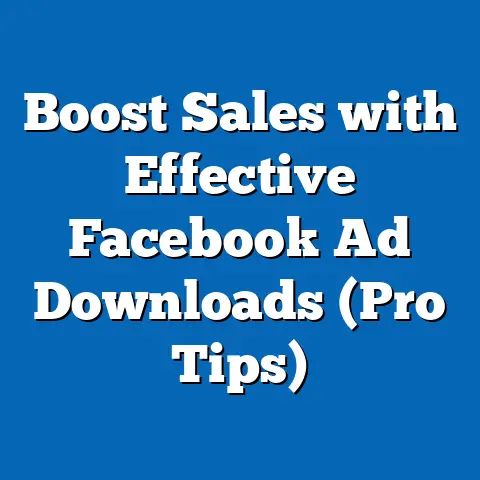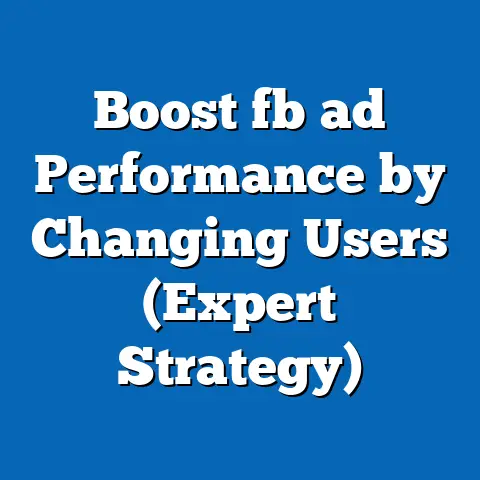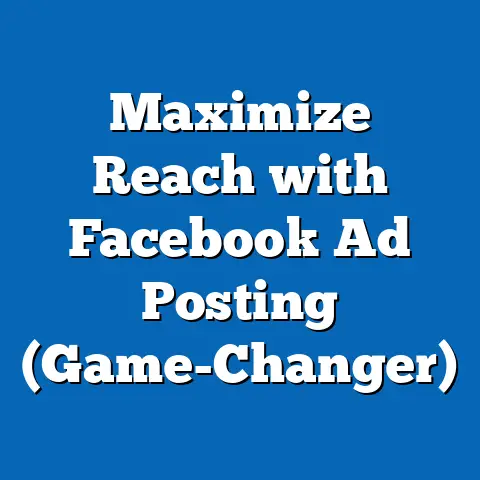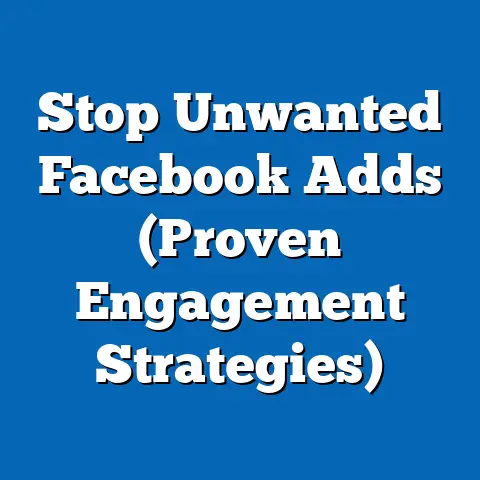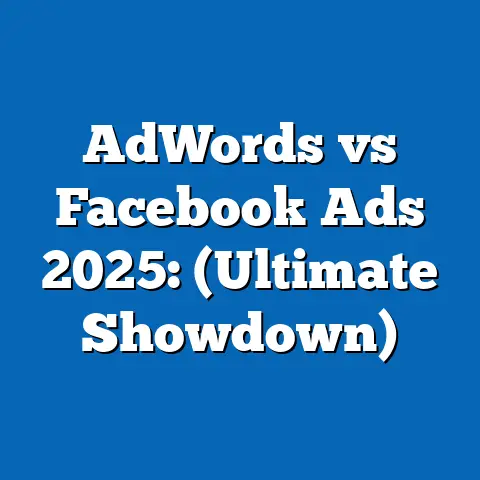Targeting Fans with Facebook Ads (Strategic Insights Revealed)
In the ever-evolving landscape of digital marketing, Facebook Ads have emerged as a powerhouse for businesses and creators aiming to connect with their target audience. With over 2.9 billion monthly active users as of 2023, according to Meta’s official reports, Facebook remains the largest social media platform globally, offering unparalleled opportunities for advertisers to reach diverse demographics. The ability to target fans—those who already engage with a brand or content—has proven to be a game-changer, driving higher engagement rates and return on investment (ROI).
Section 1: The Power of Facebook Ads in 2023
A Global Advertising Giant
Facebook Ads continue to dominate the digital advertising ecosystem, with Meta reporting ad revenues of $114.9 billion in 2022, a significant portion driven by targeted campaigns. According to eMarketer, Facebook accounts for nearly 20% of global digital ad spending, showcasing its influence over competitors like Google and TikTok. This dominance is fueled by the platform’s sophisticated targeting tools, which allow advertisers to pinpoint specific audiences based on interests, behaviors, and demographics.
The platform’s ability to target “fans”—users who have liked a page, engaged with content, or interacted with a brand—has become a cornerstone of effective advertising. Studies by Hootsuite reveal that ads targeting existing fans can achieve up to 40% higher click-through rates (CTR) compared to cold audiences. This highlights the value of leveraging an already engaged audience as a foundation for ad campaigns.
Why Fans Matter
Fans are not just numbers; they represent a community of individuals who have already expressed interest in a brand or creator. According to a 2022 report by Sprout Social, 76% of consumers are more likely to trust content shared by brands they follow, making fan-targeted ads a trust-building tool. Additionally, targeting fans often results in lower cost-per-click (CPC), with Meta data indicating an average CPC of $0.97 for fan-based campaigns compared to $1.50 for broader audiences.
This cost efficiency, combined with higher engagement, makes fan targeting a strategic priority for advertisers looking to optimize budgets. However, the challenge lies in balancing fan engagement with the need to attract new users—a dynamic we’ll explore in later sections.
Section 2: Key Statistics and Trends in Fan Targeting
Engagement Metrics That Stand Out
The effectiveness of targeting fans with Facebook Ads is evident in engagement metrics. A 2023 study by Socialbakers found that fan-targeted ads achieve an average engagement rate of 6.5%, compared to just 2.3% for non-fan audiences. This gap underscores the importance of building a loyal fan base before launching large-scale ad campaigns.
Moreover, video ads targeting fans see particularly strong results, with completion rates 35% higher than those for broader demographics, according to Meta’s internal analytics. This trend aligns with the growing preference for video content, as 54% of Facebook users report watching videos on the platform daily, per a 2022 Statista survey.
Historical Trends vs. Current Data
Looking back, fan targeting wasn’t always as refined as it is today. In 2015, Facebook’s ad platform relied heavily on basic demographic targeting, with limited tools for engaging existing fans. By 2018, the introduction of Custom Audiences allowed advertisers to upload lists of fans or use pixel data to retarget engaged users, revolutionizing campaign precision.
Fast forward to 2023, and fan targeting has evolved with AI-driven algorithms that predict user behavior based on past interactions. eMarketer reports that 68% of marketers now use Custom Audiences for fan targeting, up from 42% in 2019. This shift reflects a growing recognition of the value of personalized advertising in a competitive market.
Emerging Trends in Fan Targeting
One notable trend is the rise of micro-targeting within fan bases. Instead of targeting all fans uniformly, brands are segmenting fans by engagement level—such as frequent commenters versus passive likers—resulting in a 25% increase in conversion rates, per a 2023 report by HubSpot. Additionally, the integration of Facebook Shops and dynamic ads allows for seamless product recommendations to fans, with Meta noting a 30% uptick in sales conversions for e-commerce brands using these tools.
Another trend is the focus on community-building through ads. Brands are increasingly using fan-targeted ads to promote exclusive content or events, fostering a sense of belonging. This approach has led to a 15% increase in fan retention rates, according to Sprout Social’s 2023 data.
Section 3: Demographic Insights for Fan Targeting
Who Are the Fans?
Understanding the demographics of fans on Facebook is crucial for crafting effective ad campaigns. As of 2023, Statista data shows that 56% of Facebook users are aged 25–44, making this group the largest and most active demographic for fan engagement. Within this age range, 52% are male and 48% are female, indicating a near-evenly split audience for most brands.
However, demographic patterns vary by industry. For instance, beauty and fashion brands report a fan base that is 70% female, while tech and gaming brands skew 65% male, according to a 2022 eMarketer analysis. Geographic differences also play a role, with urban users in the U.S. and Europe showing 20% higher engagement rates with fan-targeted ads compared to rural users, per Meta’s regional data.
Behavioral Patterns Across Demographics
Behavioral insights reveal how different demographics interact with fan-targeted ads. Younger fans (18–24) are more likely to engage with interactive content like polls or Stories, with a 40% higher interaction rate compared to older users (45+), according to Hootsuite’s 2023 report. Conversely, the 35–54 age group shows a stronger preference for informational ads, with a 30% higher click rate on content offering tips or tutorials.
Income levels also influence fan behavior. High-income users (earning over $75,000 annually) are 25% more likely to convert on premium product ads targeted to fans, while lower-income users respond better to discount-driven campaigns, per a 2022 Statista survey. These patterns highlight the need for tailored messaging within fan segments.
Section 4: Methodologies for Effective Fan Targeting
Building and Segmenting Your Fan Base
The first step in targeting fans is building a robust fan base through organic engagement. Encouraging users to like a page or join a group can create a pool of potential targets. Meta recommends using engaging content like live videos or giveaways, which have been shown to increase page likes by 18% on average.
Once a fan base is established, segmentation is key. Using Facebook’s Audience Insights tool, advertisers can categorize fans by demographics, interests, and engagement frequency. For example, creating separate ad sets for “highly engaged fans” (those who interact weekly) versus “occasional fans” can improve CTR by 22%, according to a 2023 case study by Socialbakers.
Leveraging Custom and Lookalike Audiences
Custom Audiences are a powerful tool for fan targeting, allowing advertisers to upload lists of existing fans or use website pixel data to retarget users. Meta reports that Custom Audience campaigns achieve a 50% higher ROI compared to standard interest-based targeting. This methodology is particularly effective for re-engaging lapsed fans, with a 30% reactivation rate reported by eMarketer in 2022.
Lookalike Audiences, which target users similar to existing fans, offer a way to expand reach while maintaining relevance. A 2023 HubSpot study found that Lookalike Audiences based on top-performing fans generate 35% more conversions than generic demographic targeting. Combining these tools creates a balanced strategy for both retention and growth.
Testing and Optimization
A/B testing is critical for refining fan-targeted campaigns. Testing variables like ad copy, visuals, and call-to-action (CTA) buttons can reveal what resonates most with fans. Meta’s data indicates that campaigns with at least three ad variations see a 15% improvement in performance metrics.
Optimization also involves monitoring key performance indicators (KPIs) like CTR, CPC, and conversion rates. Tools like Facebook Ads Manager provide real-time analytics to adjust campaigns on the fly. For instance, reallocating budget to high-performing fan segments can boost overall ROI by 20%, per a 2022 Socialbakers report.
Section 5: Data Visualization Description for Fan Targeting Insights
To illustrate the impact of fan targeting, imagine a bar chart comparing engagement rates across audience types. On the X-axis, you’d see categories like “Fans,” “Custom Audiences,” and “Cold Audiences,” while the Y-axis measures engagement rate (percentage). The “Fans” bar towers at 6.5%, significantly higher than “Cold Audiences” at 2.3%, with “Custom Audiences” falling in between at 4.8%, based on Socialbakers’ 2023 data.
A second visualization could be a line graph tracking the historical rise of fan-targeting adoption among marketers from 2015 to 2023. The line shows a steady climb from 20% adoption in 2015 to 68% in 2023, per eMarketer data, highlighting the growing reliance on this strategy. These visuals would provide readers with a clear, at-a-glance understanding of key trends and performance metrics.
Section 6: Challenges and Ethical Considerations
Privacy Concerns and Data Restrictions
While fan targeting offers immense potential, it comes with challenges, particularly around privacy. The 2021 rollout of Apple’s iOS 14.5 update, which limited tracking via the App Tracking Transparency (ATT) framework, impacted Facebook’s ability to gather user data. Meta reported a $10 billion revenue loss in 2022 due to these changes, and small businesses saw a 20% drop in ad effectiveness, per a 2022 Shopify study.
Advertisers must now navigate stricter data policies while maintaining transparency with fans. Communicating how data is used can build trust, as 64% of users are more likely to engage with brands that prioritize privacy, according to a 2023 Pew Research survey.
Avoiding Audience Fatigue
Another challenge is audience fatigue, where fans are overexposed to ads, leading to declining engagement. A 2022 Sprout Social report found that 38% of users unfollow brands due to repetitive ad content. To mitigate this, advertisers should cap ad frequency (Meta suggests a limit of 2–3 impressions per week per user) and diversify creative assets.
Ethical considerations also come into play. Targeting vulnerable fan segments with manipulative messaging can erode trust and damage brand reputation. Adhering to Meta’s advertising policies and focusing on value-driven content can help maintain a positive relationship with fans.
Section 7: Case Studies of Successful Fan Targeting
Case Study 1: Small Business Success
A small U.S.-based bakery used fan targeting to boost holiday sales in 2022. By creating a Custom Audience of fans who had engaged with their page in the past six months, they launched a campaign promoting seasonal treats. The result was a 45% increase in online orders and a 30% lower CPC compared to their previous non-targeted campaigns, as reported in a Meta case study.
This success was attributed to personalized messaging and exclusive discounts for fans, demonstrating the power of rewarding loyalty. Small businesses with limited budgets can replicate this by focusing on high-value fan interactions over broad reach.
Case Study 2: Global Brand Engagement
A global sportswear brand leveraged fan targeting to promote a new product line in 2023. Using segmented fan lists (e.g., frequent buyers vs. casual likers), they delivered tailored video ads, achieving a 50% higher engagement rate among fans compared to new audiences, per a HubSpot analysis. The campaign also used Lookalike Audiences to attract similar users, resulting in a 20% growth in page followers.
Section 8: Broader Implications and Future Trends
The Evolving Role of Fan Targeting
Fan targeting on Facebook Ads is more than a tactic; it’s a reflection of the broader shift toward personalized marketing. As consumers demand more relevant content, brands that prioritize fan engagement will likely see sustained growth. eMarketer predicts that by 2025, over 80% of digital ad budgets will involve some form of audience segmentation, with fan targeting at the forefront.
The integration of AI and machine learning will further refine fan targeting capabilities. Meta’s ongoing investments in predictive analytics suggest that future campaigns could anticipate fan behavior with even greater accuracy, potentially increasing conversion rates by another 20–30%, per industry forecasts.
Implications for Businesses and Creators
For businesses, the implications are clear: building and nurturing a fan base is an investment in long-term success. Small businesses can compete with larger players by focusing on community-driven ads, while global brands can use fan insights to inform product development and marketing strategies.
Creators, too, stand to benefit. Influencers and content creators can use fan-targeted ads to promote exclusive content or merchandise, strengthening their personal brand. As competition for attention intensifies, the ability to connect authentically with fans will be a defining factor in digital success.
Looking Ahead
The future of fan targeting on Facebook Ads will likely be shaped by privacy regulations and technological advancements. Advertisers must adapt to a cookieless world by leveraging first-party data (like fan interactions) while exploring emerging formats like augmented reality (AR) ads, which Meta reports have a 70% higher engagement rate among test users.
Ultimately, the key to leaving a lasting impression lies in understanding and valuing fans as more than just metrics. By combining data-driven strategies with genuine engagement, businesses and creators can harness the full potential of Facebook Ads to build lasting connections in an ever-changing digital landscape.

